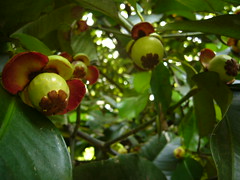By : Cindy Heller
The mangosteen is considered as one of the most important fruits because it has various beneficial nutrients and antioxidants. This article will explore various parts of the mangosteen to give you some basic understanding on this useful fruits.
Mangosteen plant
The mangosteen plant is part of Guttiferae group, a family of largely tropical trees and shrubs that secrete a kind of acrid yellow resinous juice. It is widely believed that mangosteen plant comes from the Southeast Asia region. Some experts suggested that the mangosteen plant was first domesticated in Thailand or Burma and for many years, the mangosteen fruit is shipped from Singapore to Calcutta, India, and China due to its medicinal benefits.
The mangosteen plant is an erect and very slow-growing tree with a pyramidal crown that can reach twenty to eighty-two feet in height with dark-brown or almost black flaking bark, which contains much yellow, gummy, and bitter latex. The mangosteen plant cannot grow properly on limestone, but it will do best in deep and rich organic soil. In some locations like India, the best place where it can grow is on clay contains much coarse material with a little silt.
Mangosteen seed
Even if it is called the mangosteen seed, it cannot be considered as a seed because they are actually adventitious embryos with no sexual fertilization. When the mangosteen seed starts growing, firstly a shot will emerge from one end of the seed and a root will start from the other end. This root is only short-lived, which will soon be replaced with other roots that develop at the base of the shoot.
The mangosteen seed is different than other seeds as it has a vegetative process of reproduction which makes the resulting trees and fruits have little variation. It is common for the mangosteen to be propagated by its seed, but this mangosteen seed is easily to lose its vitality and need to be planted fresh or stored in moist peat moss, sawdust, or paper to keep its health.
Germination will happen within two or three weeks time and the seedlings grow slowly. They need around fifty to seventy-five percent of shading during the first three or four years, while thereafter they can grow in the full sunlight. Mangosteen seeds are sensitive to the high level of fertilizer so they should be fertilized using a more dilute fertilizer or an organic fertilizer. Mangosteen tree prefers a fertile and well drained soil, which contains an acid pH and high organic matter. During the first three years, the tree should be fertilized every three to four months while thereafter it needs to be fertilized once or twice a year.
Mangosteen fruit
The mangosteen fruit can be divided into two parts, the white center fruit and the purple outer rind or pericarp. The center fruit has some segments and there is one segment for every triangle in the blossom remnant. Mangosteen fruit is prized for its taste and some people consider it as the most delicious fruit in the world.
The mangosteen fruit has a thick and purple outer pericarp. It contains bitter latex and the purple juice acts like a permanent dye. This outer pericarp is rich with healthful xanthones as well and there are actually forty various xanthones in the mangosteen fruit.
Mangosteen pericarp
Mangosteen is beneficial for your health, but most of the nutrients are actually derived from the mangosteen pericarp and not from the fruit. Some studies found that the mangosteen pericarp has a large amount of biologically active substances, such as catechins, polysaccharides, stilbenes, and vitamins.
The taste of the pericarp is bitter, but due to proprietary method, it is possible to combine it with other delicious fruits like pomegranate and use the whole mangosteen fruit while maintaining its unique flavor. Further studies indicated that the human body has no difficulty to absorb the essential nutrients from this mangosteen pericarp.
The mangosteen pericarp is the part of the mangosteen fruit that has a high concentration of xanthones. In addition, it contains a powerful anti-inflammatory material. Xanthones are one type of antioxidants and antioxidants can combat and neutralize free radicals in our body. Free radicals are one of the greatest threats for our health because they can attack individual cell many thousand times a day and thus weakening it so it becomes more susceptible to illness and disease.
Author Resource:- Cindy Heller is a professional writer. Visit affordable mangosteen juice to learn more about mangosteen fruit juice or more mangosteen information.
Article From Article Health And Fitness
